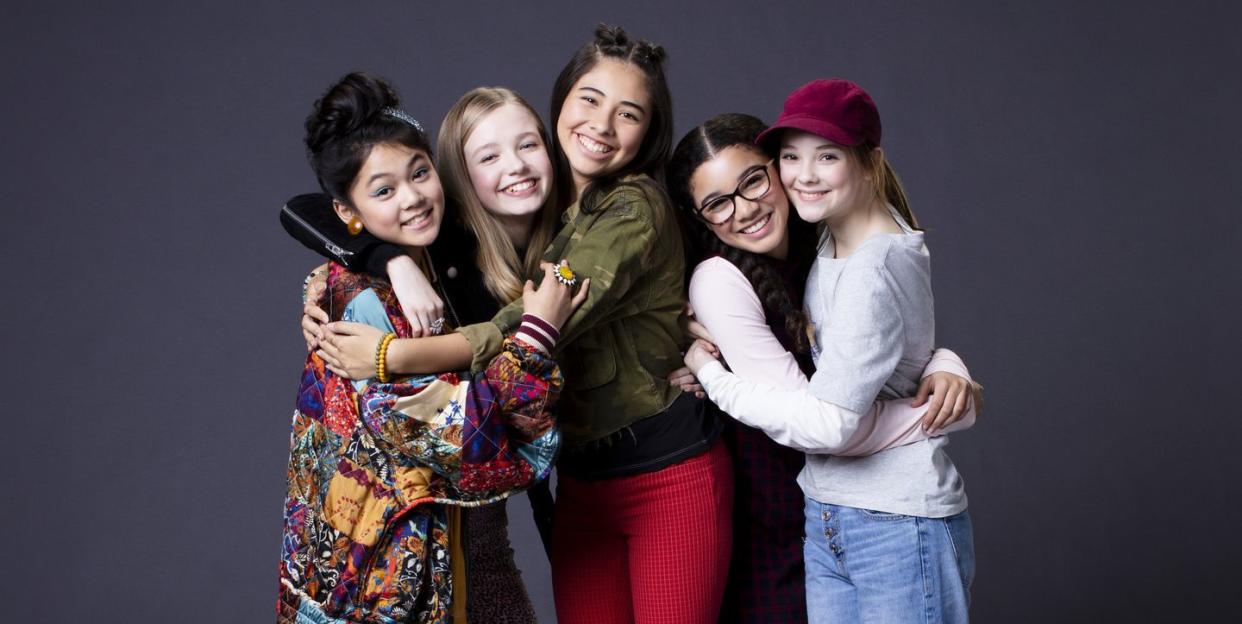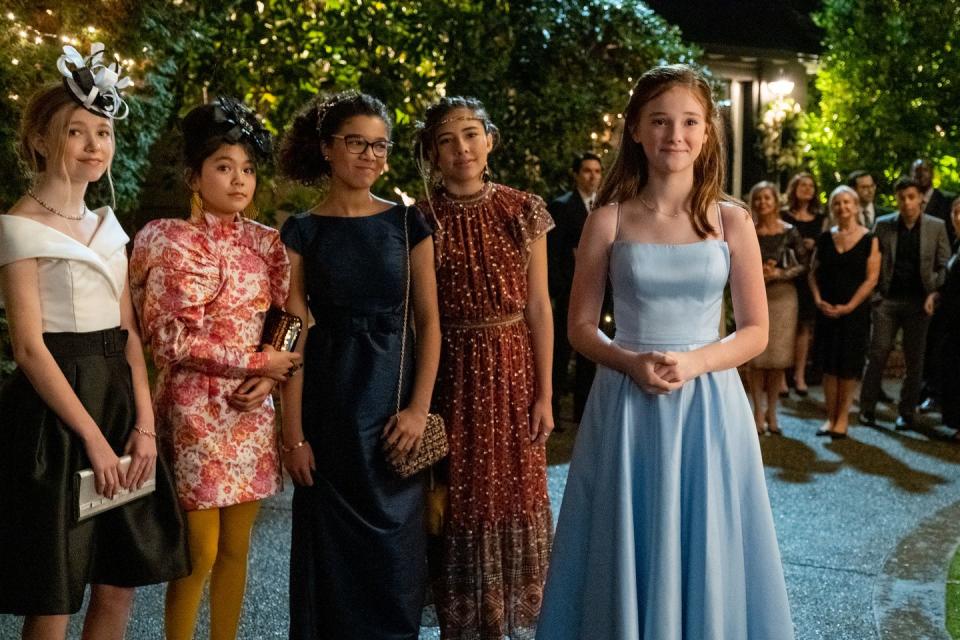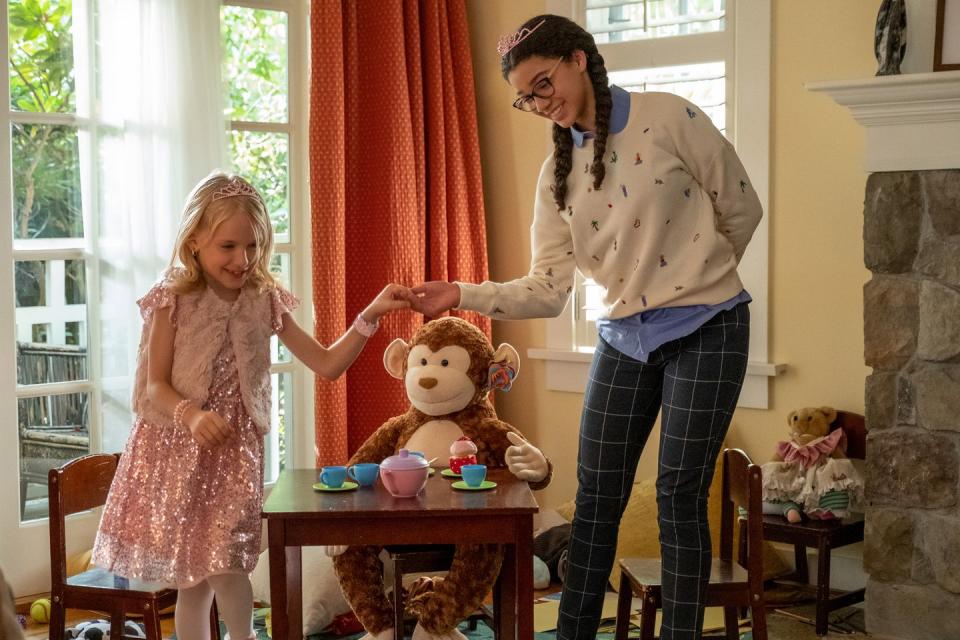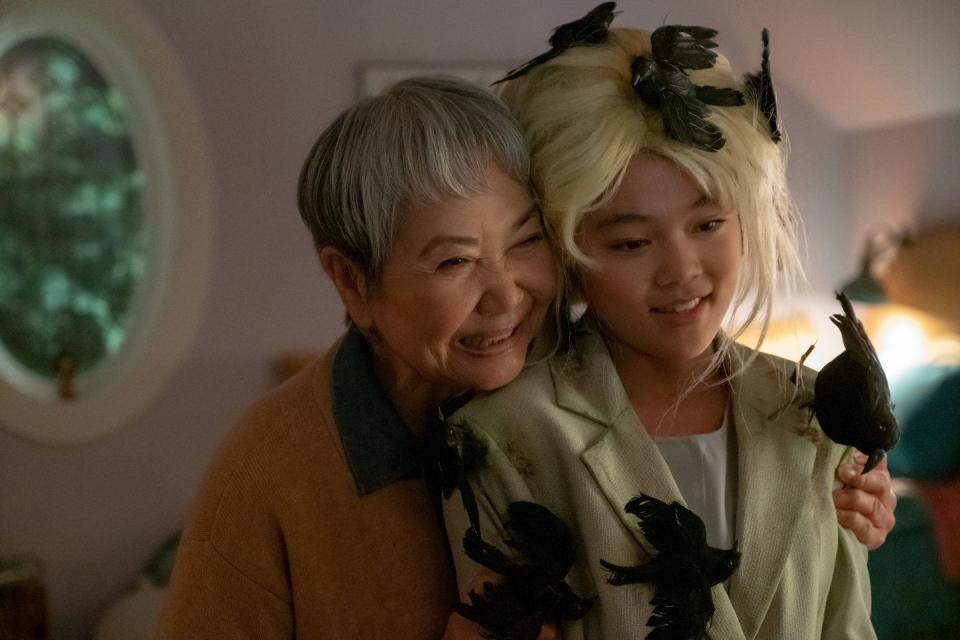'Baby-Sitters Club' Director on Reinventing the Series for a New Generation

Five middle school girls wait in anticipation for a very retro see-through landline phone to ring in a bedroom filled with art supplies, glittery hair accessories, and a varied array of junk food. For adults who grew up in the ’90s reading Ann M. Martin’s wildly popular coming-of-age book series, The Baby-Sitters Club, it’s a scene filled with palpable nostalgia—and it’s been given new life with a Netflix series reboot, which premiered last week.
As fans of the series know, the books were iconic in everything from their fashion (BSC Vice President Claudia Kishi’s outrageous outfits—handmade papier-mâché tropical fruit earrings, anyone?—have spawned countless fan blogs and homages) to their powerful depictions of supportive female friendship. They were also ahead of their time in touching on social issues including racism, adoption, divorce, and childhood illness, all of which were rare topics for children’s books during the late ’80s, when the series was first introduced. And Kristy, Claudia, Stacey, Mary Anne, and Dawn’s ability to start and run a successful business, complete with a pizza party budget and a robust paper-flyer marketing plan, all before graduating middle school, delivered an impactful message about female entrepreneurship.
The Netflix reboot captures all the nostalgic power of the books—only now with cell phones and social media, modernizing the stories for a whole new generation of fans. The cast of characters has been updated to be more racially and culturally inclusive, and plotlines touch on contemporary social issues like wealth inequality, transgender identity, and family separation.
Ahead, BAZAAR.com chats with executive producer and director Lucia Aniello (Broad City, Rough Night), a self-proclaimed BSC “extreme superfan” since childhood, about which characters she related to most (“definitely heavy Kristy”), representing real kids’ lives, and what we can all learn from the BSC today.
I have to ask—which babysitter are you?
So there’s a little bit of Stacey there, but definitely heavy Kristy. I mean, Kristy literally sits in a director’s chair. I think that if you’re somebody who’s willing to take on the responsibility to delegate authority, you are a Kristy. And [Baby-Sitters Club executive producer] Lucy Kitada often says any woman who’s successful in the industry is a Kristy by default, which I think is true.
What drew you to this project? What made you feel like people need The Baby-Sitters Club right now in particular?
I think it was about 2017 that my agent came to me with a reboot of something and I wasn’t interested. And she was like, “Well, is there anything that you would ever really want to remake?” And I was like, “Absolutely without a doubt The Baby-Sitters Club.” It was a pretty dark time—2017—in general politically, and just personally. I think there was something not just nostalgic about the series, but just comforting that everyone was looking for and wanting. And unbeknownst to us, we would only need it and want it more and more as time progressed.
My agent tracked down the rights and Mike (Michael) De Luca Productions had them, and Lucy Kitada and [executive producer] Naia Cucukov, who were spearheading the project, were also lifelong superfans. Rachel Shukert (showrunner and executive producer) also was a super fan. And when the four of us pitched it around town, it was such a unique experience because there were so many people in the room who obviously had been fans. And you didn’t have to explain to them what The Baby-Sitters Club meant; how it makes girls feel and how it spoke to them, because they already knew. They were products of those books. [With] people who hadn’t read the books, you had to describe something that felt so seminal to us; it felt almost like trying to bottle a feeling. But the execs at Netflix really got it—Jenna Boyd and Brooke Kessler and Allie James.
What was it like working with Ann M. Martin?
There’s something really special about Ann’s books that provides a blueprint that just gave us a really solid foundation. And beyond that, we had conversations with her, and she read scripts and would give us some thoughts. I was really struck by how open she was to a lot of the modernizing. There’s, of course, some worry when you want to change something that’s already so good. But she was so open to making the cast more diverse, to bringing in conversations about trans kids, and about cyberbullying—things that are far more 2020. And, of course, it makes sense that somebody who was already writing about young female entrepreneurs and female friendship would want to continue the legacy of progressive stories.

Can you talk more about how you updated the series from the books in terms of inclusivity around gender identity and race? Why was that something that was important to you?
Well, I think that for the time, the books were pretty progressive. They had a Japanese-American character—Claudia—as one of the leads, and Stacey had diabetes, and Kristy’s a child of divorce, and Mary Anne has this really strict father. There was already some DNA there in how no girl’s life is perfect, but we wanted to make it more relevant for kids today, because the world looks different than it did in 1986, when the books were first written. The modernizing—whether it is the diversity in front of the screen, or the stories [being told]—it’s partly important for representation, but it’s also important to make it feel more real, because that is the real world.
In Episode 4, “Mary Anne Saves the Day,” Mary Anne babysits a little girl named Bailey, who over the course of the episode, we learn is trans. How did that storyline come about?
“Mary Anne Saves the Day” is already about a babysitting charge who has a fever, and Mary Anne having to speak up for herself. I think it was Rachel’s idea that that could be a trans child, and we paired it with the idea of Mary Anne wanting her insides to match the outsides, wanting to feel more grown up and to have new clothes and to change her hair. And that was just something that we felt laid in so perfectly with the story as it was.
Also, it was important for us to say that, for kids, the right thing to do is so obvious. We should just care for other people no matter what they look like or who they are. When it comes to babysitting, the thing you’re responsible for is keeping children safe. Adults [debating] about what’s right and what’s wrong, and what somebody else should be allowed to do with their own body is so absurd. Just treat people with kindness, treat people with respect. Kids can sense the right thing to do in some ways more simply than some adults. And Mary Anne, being the kind of person she is, it would be so obvious to her that the misgendering at the hospital is wrong, and she has to look into herself to start to make that statement. But that was something she was ready to do, because she’s a good babysitter.

Did you design the show to appeal to older viewers who read the books in the ’80s or ’90s, as well as younger viewers? How did you navigate that intergenerational viewership?
It was always our intention that it would be made for the new generation, as well as for adults who read the books whether or not they had children. Rachel and I had both written for things like Broad City that had these fully realized, three-dimensional female characters. And for us, it was like, you can do the same thing for younger characters. You just leave out the R-rated parts or whatever. You can still make characters, even though they’re kids, just as complex and interesting. And then it makes it fun for adults and for kids to watch, because good stories and good characters are universal despite how old you are.
Broad City was such an important show in how it laid the foundation for depictions of a kind of woman that wasn’t necessarily seen a lot before, the female slacker. Do you see The BSC as working in a similar way in showing depictions of characters that aren’t seen a lot on screen?
Yeah, exactly, I think that these girls are all so unique, and young girls are just as unique and bizarre and different and interesting as adults. While Abbi [Jacobson] and Ilana [Glazer] were more of the kind of proto-slacker type that we had seen so many times with men but not necessarily women, I think these girls also are each unique, specific characters. It always kind of creeps me out when it’s like, every girl’s room is princess-y or whatever. We as a culture are putting that label on these girls to fulfill this heteronormative, hyper-gendered version of a young girl or young woman. I don’t think a single one of the [BSC] girls falls into that category. Every single child is completely unique and different. Let’s not tell them what they should like, or what they should be like, and just, like, let their freak flags fly.
What was your vision for the friendships on the show? What were you thinking about in terms of how you wanted to show female friendship?
Well, I can’t speak for all former 13-year-olds, but I remember when I was 13, my relationships were complicated. It wasn’t just like, “This is my best friend and that’s it!” There were feelings of being hurt if somebody had another friend, or being jealous, and being excited about new friendships. It’s complicated, because you’re figuring out who you are, and who you’re friends with is a big part of coming of age. I think it’s true in the [BSC] books and in the series too. These girls always have each other’s back, but it’s not always that simple. It’s complicated for these girls, and we wanted to make sure that the writers honored that idea. Hopefully, it makes kids who watch it feel like, yes, that’s like something I’ve experienced.
That’s so true, female friendship culture is often so idealized, like everything is perfect.
Yeah—or terrible. And it also always bothered me when it’s like, “Girls are meaner than boys.” I don’t know where that came from. No, they’re not—little boys can be really mean. Little girls can be mean too, but I think that’s such a sexist, misogynist blanket statement that I really always felt is not true. I think our girls show that they can be complicated and messy, but they’re not mean.
In Episode 6, “Claudia and Mean Janine,” the series takes a departure from the book when it’s revealed that Claudia’s grandmother, Mimi, is a survivor of a Japanese internment camp. Why did you decide to move in that direction?
It was so cool that Claudia’s Japanese-ness was very canonically part of the book series, but it was also interesting that it never really delved into the history of her family. And I think right now with so much of what’s going on with the immigration in this country, it feels like we’re just repeating history. And it felt like a really sad and beautiful way to remind people that not only is the past not so past, but it’s also repeating itself even in this same country right now—the idea of separating families based on nationality or ethnic origin or anything like that. I think that’s another example of something that the books had the DNA for already, and [we were] matching what’s going on in 2020 with what happened in the books, and also bringing out a little bit more history of some of the characters that were already established by Ann.
But that episode for me is certainly the most emotional one. I think it’s a very beautiful way to delve into Claudia’s inspiration, and why she creates, and for her to look inward and into her family for inspiration is just such a deeply emotional and inspiring thing. Jade Chang, who wrote that episode, did such an incredible job with it.

Do you have any plans for a second season? Are there any themes or storylines you’d like to tackle in the future?
We haven’t heard yet [about a second season], but we’re hoping. We’re feeling good, but no official word yet. At the end of the series, we introduce Mallory and Jessi, who are the junior sitters, and I think it’ll be interesting to explore some new stories with those characters. Also, Kristy’s now moved across town, and I think that she has a lot of adjusting to do. So hopefully, if we get another season, that’s something we can explore.
Personally, I’m so shipping Sharon and Richard—I think that Marc Evan Jackson and Jessica Elaina Eason are just so charming together and lovely that I hope we get to see more. And I hope Alan Gray shows up, because he was cool. Remember him? He was the guy who would always go to dances with Kristy even though she was like, “Whatever.”
And he would, like, do gross stuff with his eyes.
Yes, yes. I feel like in the opening when Kristy’s talking about how the boys were sticking Kleenex down each other’s pants, my personal feeling is that she’s talking about Alan Gray.
Any final thoughts you want to add?
Long live the BSC.
This interview has been edited and condensed for clarity.
You Might Also Like

